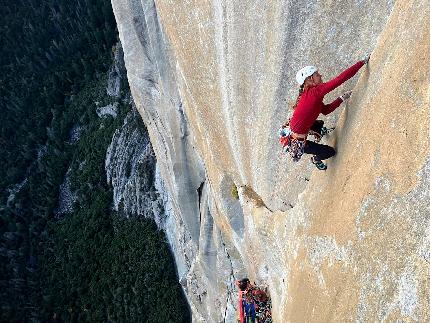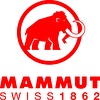Successful Scottish-Slovak climbing expedition adds multiple new routes to Torsukattak Fjord in Greenland
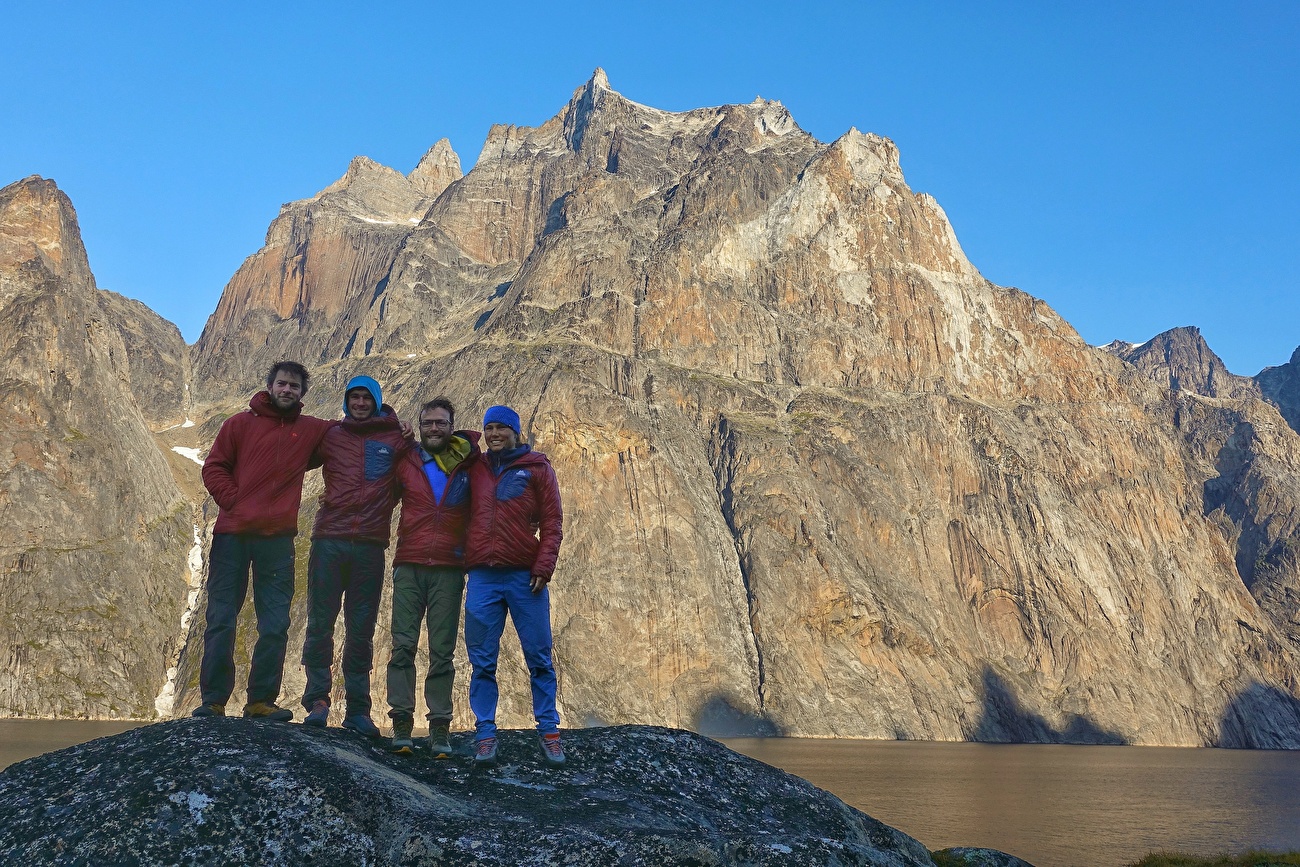
 1 / 62
1 / 62 Scottish-Slovak climbing expedition 2024
Scottish-Slovak climbing expedition 2024
Miška Izakovičová from Slovakia and Callum Johnson, Tim Miller and Simon Smith from Scotlan have returned from a successful expedition to Greenland. The team visited the Cape Farewell region of south Greenland, spending three and a half weeks climbing around the Torsukattak Fjord. They climbed a wide collection of new routes and were successful on their main objective of climbing a new route, "Mussels for Tea, Packrafts in the Sea" E6 6b (7b), on the east face of Maujit Qarqarssasia East, often referred to as The Thumbnail. This face is 1350m high and considered to be one of the largest sea cliffs in the world. The team also climbed a new route on the 800m high south headwall of Maujit Qarqarssasia East, "Texture like Sun", E3 5c (6b+), in a single push, hereby making the first known ascent of this face. In addition to these routes the team climbed eight new routes (between the grades of E2-E5) on Pamiagdluk island, including the first ascent of the tower they have called "Spire of the Northern Fire", all within walking distance of their basecamp. All routes were climbed trad, without bolts and without pegs, except for one removable bolt used to fasten a portaledge. Izakovičová provides the details.
The Torsukattak Fjord area has seen a few climbing expeditions, but it is certainly not visited very often, and the potential here is endless. Thanks to reports from previous expeditions, we knew that we could expect high quality rock and plenty of opportunities for first ascents. The main goal of our expedition was to climb a new route on the east face of Maujit Qarqarssasia East, also known as the Thumbnail. Based on available information, we knew that a few routes already existed on the wall, but all were on its left or central part, so we focused more on the right side, where the wall had remained untouched.
Right upon arriving in basecamp we were treated to bluebird skies, which prompted us to head straight for the wall. We approached the cliff by packrafts, with an idea to climb the wall over four days in capsule style. With 4 people on the wall we had 2 portaledges, close to 70 litres of water, sleeping and cooking kit and many ropes. This meant we had some exceptionally heavy bags to haul up the wall. We were keen to use natural anchors, which meant that some extremely elaborate anchors had to be constructed, sometimes using 12 points of gear in 1 anchor! The climbing proved to be of a high quality, but much easier and lower angled than we anticipated. After the first day, when our big-walling skills were put to the test on some 50m long traverse hauls over ledges, we realised that climbing was going to be the least of our worries. The hauling was a mammoth challenge as someone had to be with the bags constantly to unstick them. "Bag is stuck!" and "Haul!" became the mantra for the next few days.
We started to find a good rhythm and we all laughed as we worked. We kept climbing on high quality rock till late in the evening and then we would set up the portaledges. To start with we had been exceptionally slow and 4 days later we were only slightly faster, but 800 metres of climbing brought us to the huge halfway ledge that split the face. Bad weather forced a descent, by traversing the ledge and descending the south gully.
After a week of iffy weather spent lifting rocks with portable fingerboards, fishing and foraging for mussels, mushrooms and seaweed, the skies finally cleared. We paddled across and regained our high point at the halfway ledge. This time round we decided for a different tactic, climbing the headwall in a single push with no hauling. We set off early in the morning in two teams climbing two parallel lines. Tim and Simon climbed an immaculate corner feature up the left side of a pillar and on the other side Callum and I climbed a system of cracks and corners to regroup at the top where the lines converged for a pitch. At this point we had reached the steepest part of the wall and I set off up a tricky crack in an airy position with the whole fjord below. Callum followed this with a brilliantly sustained pitch above. Meanwhile Tim had climbed up to a steep chimney, which Simon exited via a precarious and bold move to reach easier climbing. These pitches proved to be the crux of the route and ranged from British E4 - E6 (6c-7b). The climbing above remained exposed and on quality rock right till we pulled over onto the summit late in the evening. We shared hugs all round then we started the descent. We knew this was going to be a complex and time consuming adventure in its own right.
In the fading light we descended a rocky ledge to a point where it became so steep we had to abseil. A blood red moon emerged over the horizon and time slowed as we worked into the darkness as a team to rig abseils, pull ropes, and find the next ab station. A distinct glow illuminated the sky as the northern lights made a faint appearance and a constant flow of shooting stars escorted us back along the ledge to our bivi where we made dinner and crashed into our sleeping bags. Thus "Mussels for Tea, Packrafts in the Sea" was born. 1350m, E6 6b (7b), 33 pitches.
We spent a lazy morning on our ledge, listening to music and recovering from the previous day's excursion. Eventually the sun disappeared from our ledge and we were prompted to relocate our camp to beneath the spectacular Southern headwall, which as far as we knew remained unclimbed. During the awkward load carrying Simon had tweaked his back meaning he would sadly have to miss the next day. In the morning Tim, Callum and I made quick progress up easy slabs until we stood beneath the start of the difficulties. We alternated leads, moving efficiently up corners and cracks that we had seen through binoculars. The climbing was constantly engaging, never desperate, but sustained. We each had huge smiles after every pitch, it was clear we were climbing something special! The rest of the face dropped steeply beneath us and we could even see Simon sunbathing on the ledge below. We expected the difficulties to ease higher, but they never let up until we climbed a final pitch up a tower, which we were surprised to find brought us straight onto the summit. We gathered on the top just as the sun sank behind a rugged horizon of rocky spires, bathed in a deep orange glow. It was a very special moment and we would have stayed longer if it weren't for a bitterly cold wind. We knew that this time an even longer descent with tricky route finding awaited us. We spent another starry night slowly finding our way down back to our bivy. And so "Texture Like Sun" was created. 800m, E3 5c (6b+).
After this adventure we were done with packrafting and decided to climb the walls within walking distance from our basecamp. The great weather forecast for the rest of our stay allowed us only one day of rest. During this time we split into two teams and set off aiming for different peaks.
Tim and I were eager for an adventure of untouched ground and headed for an unclimbed orange spire on the top of the main ridge of Pamiagdluk Island. The approach took us all day and required some steep hiking, scrambling and simul-climbing over exposed ridges. We set up a bivy with a great view of the spire and only then did we realise how many great lines the wall had to offer. It was hard to choose which one to climb first. The approach from the bivy proved to be more difficult and time consuming than we had anticipated, but we were rewarded with high-quality orange granite and amazing splitter cracks. Over the following two days we climbed three new routes, each one following the obvious lines and each one better than the last: "Come with me if you want to climb" E2 5b (6b) 150m, "Aurora Arena" E4 5c (6c) 110m, "Peaches and Bumcakes" E5 6c (7b) 220m.
During the second night at the bivouac, while we were melting snow for water, we witnessed perhaps the most amazing natural phenomenon we had ever seen, the Northern Lights directly above the spire. And that’s how it got the name we gave it, ‘The Spire of the Northern Fire’.
During the good spell of weather at the end of the trip Callum and Simon teamed up. Callum takes up the story: "We first walked up the Baroness Valley scoping out potential for new climbing. The left hand side of the west face of Mark was attractive orange granite and was featured with twisting corners and splitter cracks. We climbed 400m of sustained and continually interesting climbing; two pitches of E4/5 6a (6c+) were the crux of the route and involved all sizes of cracks from layback seams to hand-fist stacks. The north ridge was descended by downclimbing and one abseil to gain the north col. The late start meant a sunset finish, a little bonus, but a walk back to basecamp in the dark with one headtorch between us. "Warmonger" E4/5 6a (6c+), 400m.
The Baron is an inspiring mountain, likened to Les Drus by the French first ascensionists. We knew of previous teams activity in the area, but we hoped to find something new to climb. On the approach to the SSW face we couldn't take our eyes off the line of the crag - visible from a kilometer away was a towering orange corner. From our vague notes this was obviously ‘The Red Dihedral’ E3 6a (Cowie and Marsh 2005). Another line up the centre of the lower wall inspired us, this was reckoned to be ‘Amphibian’ E5 6a (Bremner and O’Sullivan 2005). We opted to try and link these features and in the process added two new pitches. The scale of things was hard to comprehend, distances seemed to multiply, and features grew disproportionately. We soon realised that our mega link up on the Barron was a very ambitious plan, time was racing on faster than we were. We made a swift and safe bail from the face - bailing in style. The next morning we climbed the first two pitches of ‘Supercrack of Greenland’ (E3 5c) before descending to base camp."
Miška again: After four days of adventures, we all met at basecamp, to find that the weather would continue to be great for the remaining few days of the trip. So, filled with excitement, we shared all our stories over dinner, prepped meals and decided to head to the Baroness Valley together.
With a tip off from Simon and Callum, Tim and I decided to climb a new line to the right of ‘Warmonger’, the route put up by them a few days earlier. We were hoping for an easier and shorter day, but because we faffed around on the second pitch for several hours, trying to climb a unprotectable corner where Callum and Simon had also struggled before us, we ended up with another late night descent. At this point we were desperately running out of abseil tat, which forced us to downclimb the easiest line on the left hand side of the wall. Great climbing up the cracks and corners with one pitch of runout slab climbing led to the creation of our route: ‘Slow off the Mark’ E4 5c (6b+), 300m on the west face of Mark.
While climbing on Mark our attention was drawn to a prominent and yet unclimbed orange wall across the valley. Suddenly the plan for our last day was clear. We didn't have an exact idea of which line we would climb, but it was evident that we would have about 300m of climbing on low-angled slabs before reaching the steep upper headwall. We started climbing up the highest part of the wall moving together across the entry slabs. I spotted a feature in the middle of the wall above which I immediately referred to as a "dream corner". Every pitch followed beautiful cracked corners and the climbing was very high quality, unbelievably consistent and interesting all the way to the very top of the wall. As far as we know the wall had not been climbed so we appropriately named it ‘Orange Wall’ and, unsurprisingly, we named our route ‘Dream Corner’. ‘Dream Corner’ E3 5c (6b+) 600m (300m of VS (4c) to the base of the headwall + 300m of climbing on headwall)
Back to Callum: "Whilst Miška and Tim were climbing on the west face of Mark, Simon and I climbed the line we had seen on Campsite Hill Crag (Baroness Valley). This gave 7 pitches of climbing on the south facing wall up to E2 5c (6b) to the summit of this subsidiary peak. We descended into the gully on the east by downclimbing and two free hanging 60m abseils. We called the route ‘Lord of the Kamikaze Eye Flies’, a nod to the black flies which seem to always want to be in your eyes, and also our time spent stranded on this uninhabited island, hopefully looking after ourselves better than the characters of the classic novel.
We walked up to the col north of Mark and bivvied there for the night, not before looking at the east face of Mark to assess the possibilities, the face was unclimbed, the only photo we had seen was by Tim from The Spire of the Northern Fire and showed the cliff in profile. We stashed our gear below the most likely looking line.
Again we woke in our bivvy above the clouds, the first light of the day was tickling the pointed summits of the skyline. We walked below the east face of Mark, the lower quarter of the face had been polished smooth by a glacier which had left behind very few climbable lines on the lower section. The easiest option turned out to be a technical sustained steepening corner line. The rock quality again was impeccable. The flake-crack line on the third pitch petered out and we escaped by a diagonal downwards traverse to gain the slim corner on the right. Higher up a thin flake up the wall left of the arete was climbed, the crux of the route was overcome. We descended the north ridge as before back to our bivvy spot. ‘Inversions’ E4 6a (6c), 280m, in memory of the frequent temperature inversions experienced in the Fjord - it was always warmer on the wall than at basecamp by the sea. We all celebrated with a swim in a glacial lake, a refreshing way to celebrate our successes of the day and of the trip."
We would like to give a big thank you to the organisations that supported our trip. These are: Tirio packrafting, Packraft Adventure, Mountain Equipment, The Mount Everest Foundation, The Alpine Club, The BMC, The Slovak Climbing Federation, The Scottish Mountaineering Club, The Scottish Arctic Club, The Gino Watkins Memorial Fund, Lyo Food



 Copia link
Copia link

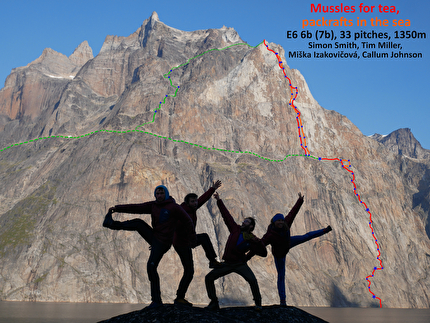
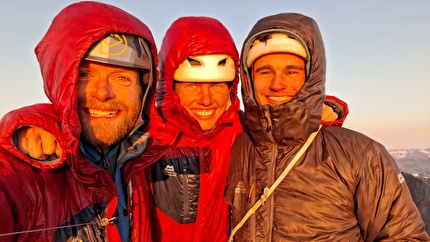
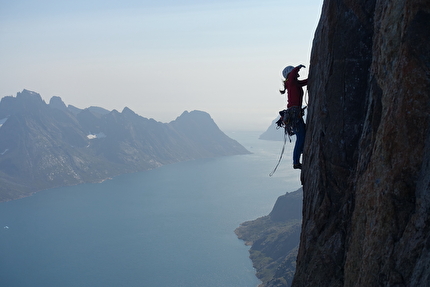
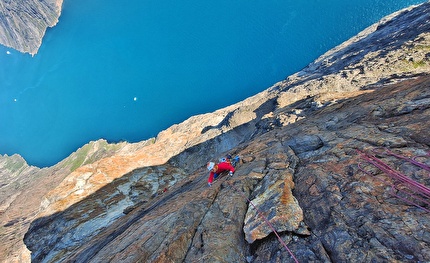
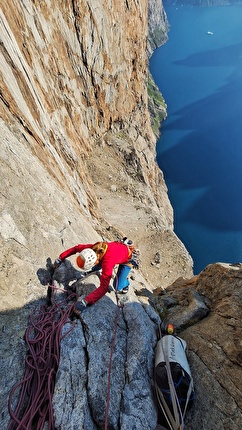
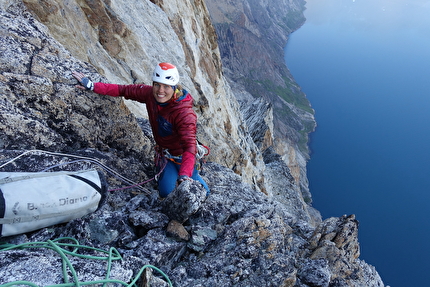
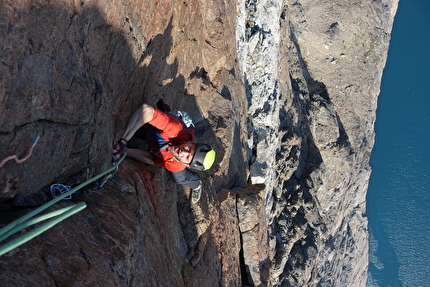
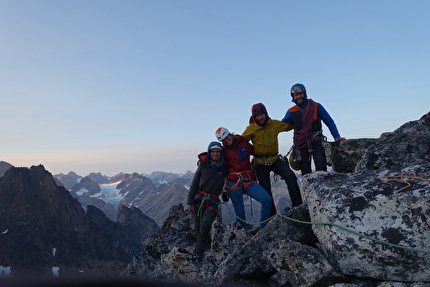
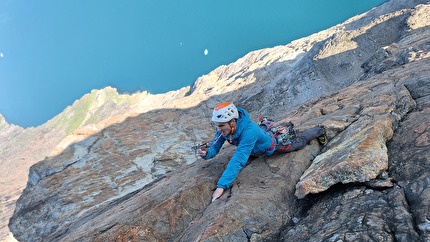
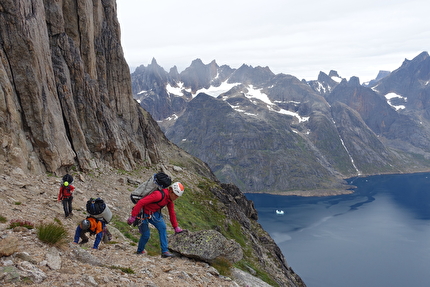
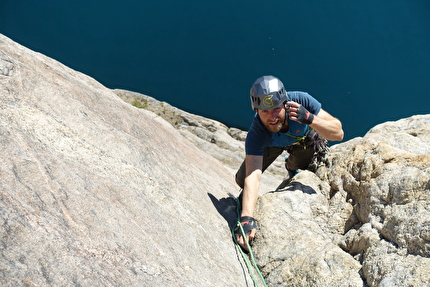
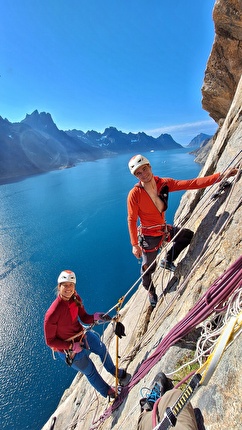

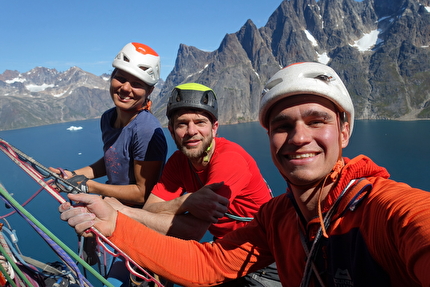
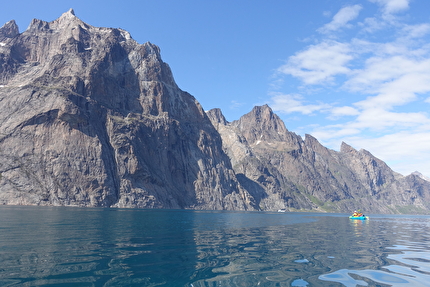
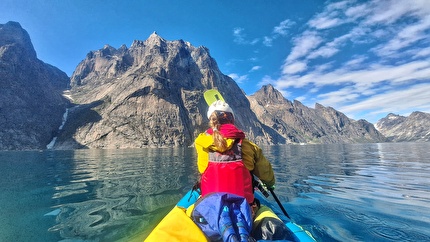
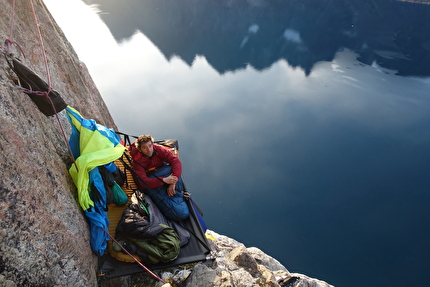
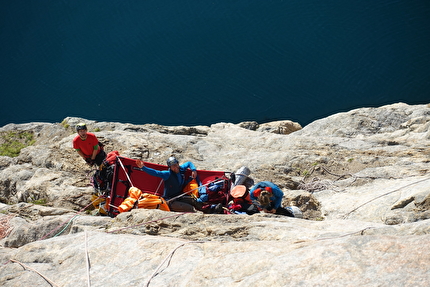
 See all photos
See all photos